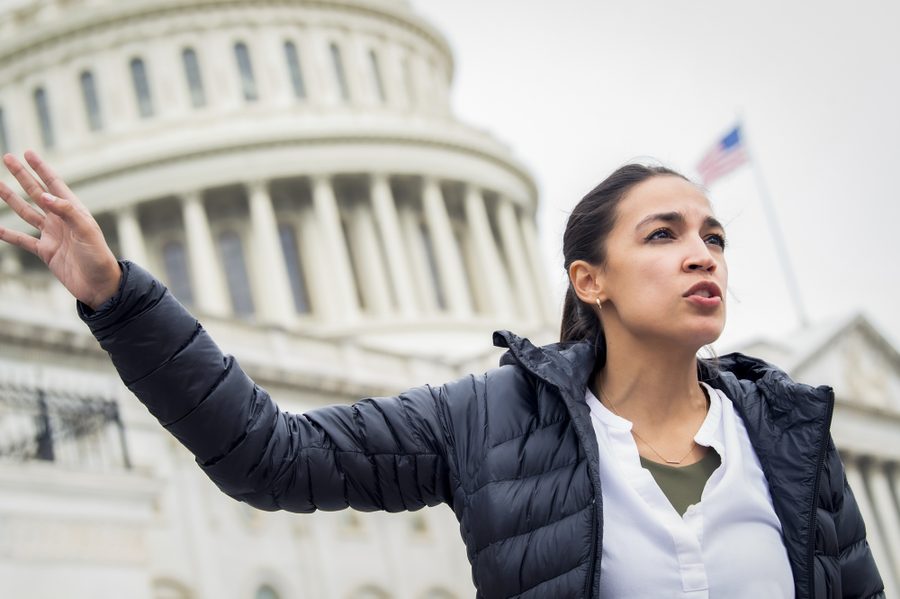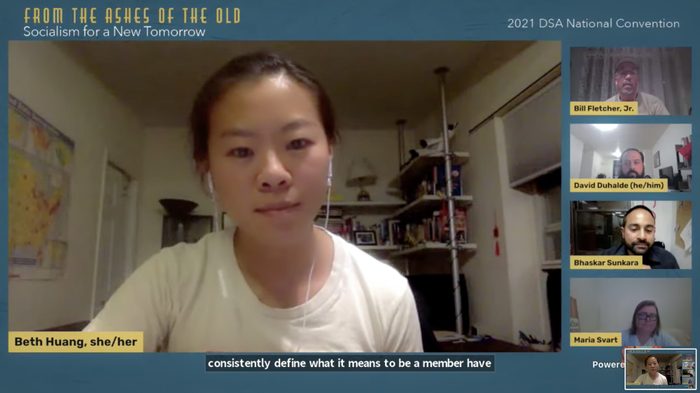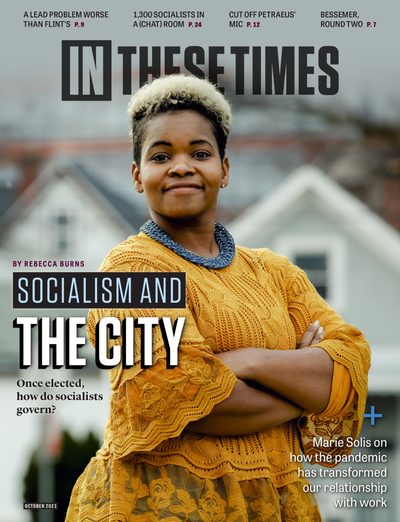Democratic Socialists of America Make a Strategy for the Biden Era
Delegates chart a socialist future at DSA’s 2021 virtual convention.
Roger Kerson

On July 30, Rep. Cori Bush (D-Mo.) began an around-the-clock sit-in on the Capitol steps. Acting more like an organizer than an elected official, Bush was protesting the expiration of the eviction moratorium that offered protection to more than 11 million renters during the pandemic. On August 3, when the St. Louis congresswoman finally went home to sleep, she was relieved by Rep. Alexandria Ocasio-Cortez (D-N.Y.), who gave a video shout-out to their fellow members of the Democratic Socialists of America (DSA). The group was virtually caucusing at its biennial national convention.
“Hey what’s up DSA!” Ocasio-Cortez said. “We are relieving sister Cori Bush out there for a little while…I just hope you have an amazingly positive and wonderful experience on this third day of the convention. So, thank you so much, and we are holding it down out here. We hope you hold it down out there. Solidarity.”
Bush, a registered nurse and pastor, got involved in community organizing during the 2014 protests over the police killing of Michael Brown in Ferguson, Mo. Now a first-term member of Congress, her focus on housing issues aligns closely with that of DSA. Cea Weaver, a member of New York City DSA who serves on DSA’s National Housing Justice Commission, says roughly 35 DSA chapters are actively working on the issue.
“Like labor, housing organizing is a clear way that we come into direct conflict with the ownership class,” Weaver says. DSA, she adds, draws inspiration from a long line of socialist, labor and tenant organizers who, in the early 20th century, passed the first rent control laws in the country and organized some of the largest rent strikes in history.
These are heady days for the U.S. socialist movement. After 100 years in the political wilderness, left-wing activists are winning support for causes and candidates that emphasize, rather than avoid, “conflict with the ownership class.”
DSA, the largest socialist organization by far in the United States, now clocks in at about 95,000 members — a growth of 1,400% in six years. (In 2015, the group numbered about 6,500.) The surge has been fueled by much younger members, reversing what had appeared to be an inevitable demographic decline: In 2015, the average age of a DSA member was over 60. Now, it is under 30.
The House now includes four DSA members: Bush and Ocasio-Cortez, along with Reps. Jamaal Bowman (D-N.Y.), and Rashida Tlaib (D-Mich.), both of whom spoke at the convention. Dozens of DSA members have also won seats in state, city and county government.
And over in the Senate, a certain octogenarian from Vermont has oversight over the entire federal budget at a time when it is larger than ever.
On Democrats and democracy
From August 1-8, 1,300 DSA delegates convened on Zoom to wade through procedural issues and unanimously pass a new national DSA platform. The platform includes, among other things, calls for defunding the police, legislation for reparations, “social ownership of all major industry and infrastructure,” a four-day workweek, and the abolition of the Senate and the Electoral College.
Delegates also considered 194 pages of resolutions and changes to DSA’s constitution and by-laws. Several items were the subject of heated debate. Delegates approved a resolution for DSA to continue “its successful approach” of running candidates on the Democratic Party ballot line — a nuanced shift from the 2019 convention. A resolution passed that year did not “rule out” the use of the Democratic ballot line by socialists, but strongly emphasized more independence of the two-party system.
Of course, any time multiple socialists get in a room, multiple answers to essential questions should be expected. Such disagreements notoriously lead to sectarian splits.
Longtime DSA members take pride that their organization was conceived as a merger. Founded in 1982, DSA sought to heal earlier decades of left-wing division, uniting the Old Left (represented by the Democratic Socialist Organizing Committee, or DSOC, a descendant of the Socialist Party of America of Eugene Debs) with the New Left (represented by the New American Movement, or NAM, formed primarily from members of Students for a Democratic Society). Having formed as a big-tent, multi-tendency organization open to all, the pre-2015 DSA had one unifying strategic imperative: Socialists should work electorally within the Democratic Party to support socialist candidates and causes and not play the third-party spoiler role.
In These Times’ founding Editor & Publisher James Weinstein was active in — and critical of — both DSOC and NAM. In an April 1982 editorial, he heralded the establishment of DSA as the organization “with the greatest potential for bringing socialist principles and social goals into the mainstream of American political life.” And DSA’s potential, he wrote, “lies in its commitment to participation in the electoral process.”
This commitment, which was once referred to as a “realignment,” is no longer a common denominator in the newer, younger, larger DSA. Today’s DSA recruits include not just the unchurched who are first learning about “socialism,” but socialists from various flavors and denominations of Marxism, Leninism, Trotskyism and other widely divergent doctrines and ideologies.
Many socialists from these traditions have long viewed DSA’s reformist strategies — courting top trade union leaders, collaborating with Democrats — as a dead-end for the working class. Much better, they argue, to build “socialism from below” with rank-and-file agitation and a long-term goal of creating an independent political party.
Along came Bernie
These debates, which have often divided different socialist groups, are now taking place within DSA. Meanwhile, the wide popular support for Bernie Sanders’ two presidential campaigns prompted many on the Left to rethink political strategy.
“The experience we had in the Bernie campaign forced a lot of us to change our position,” says Eric Blanc, a labor sociologist and delegate-at-large to this year’s DSA convention. “Far from weakening the Left, [the campaign] helped to build one of the largest groups on the socialist Left in a generation.”
Along with other socialists from various traditions, Blanc found a new political home in DSA not long after 2016, when Sanders’ polemical — yet pragmatic — campaign against “the millionaires and the billionaires” won more than 13 million votes in the Democratic primaries. Fueled additionally by the high-profile congressional victory of DSA member Ocasio-Cortez in 2018, as well as Sanders’ second presidential run in 2020 and the Left’s general revulsion toward former President Donald Trump, tens of thousands of new recruits flooded into DSA.
“The Left is so weak,” Blanc told In These Times after this year’s convention. “You can make a lot more change when you agree to disagree on some theoretical and strategic points for the sake of having a successful big-tent organization.”
Writing in Jacobin in 2017, Blanc had tried to square the circle on that persistent theoretical and strategic question of how socialists should engage with electoral politics. He argued for a “dirty break” from the U.S. political duopoly — to elect socialists until socialists could effectively break off into their own party, to use “Democratic and Republican ballot lines to implode the two-party system.” (This idea contrasts with a “clean break,” favored by committed third-party advocates, to simply not engage with the two parties.)
This dirty break debate framed one of the most controversial questions about electoral strategy during this year’s DSA convention. Resolution No. 8, which passed, states DSA “will continue its successful approach of tactically contesting partisan elections on the Democratic ballot line while building power independent of the Democratic party apparatus.”
Bread & Roses, one of the larger DSA caucuses (a self-described “caucus of Marxist organizers”), took a member vote in advance of the convention on a “dirty break amendment” to Resolution 8. Only 55% supported language that called on DSA to “reject the strategy of capturing the capitalist-controlled Democratic Party” and to encourage any DSA-endorsed candidate to identify publicly as “running against the Democratic Party’s corporate establishment.”
With the margin so close, the caucus made no endorsement and published pro and con articles in its online magazine, The Call. Writing the position against the amendment was none other than Eric Blanc. While he still believes in fighting for a “mass workers’ party” in the long run, he is now skeptical “of foregrounding a break with the Democratic Party,” he told In These Times. Many of the people DSA wants to attract to socialist ideals, says Blanc, “are sectors of the working class that vote Democratic.”
“Instead,” he wrote for The Call, “we should focus on discussing why and how chapters should build strong independent socialist electoral apparatuses now.”
A new internationalism
Convention delegates also vigorously debated a resolution for DSA to affiliate with the São Paulo Forum, a gathering of left political parties in Latin America.
Joining the São Paulo Forum, according to two of the resolution’s coauthors, Morgan Dowdy and Jack Suria-Linares, would be an important step for DSA, which they describe as “the largest socialist organization in the imperialist behemoth to the North.”
But not so fast, said Jared Abbot in a contrasting pre-convention piece in The Call. The São Paulo Forum, according to Abbot, is now viewed as “closely associated with authoritarian governments in Venezuela, Nicaragua and Cuba.” As a result, he pointed out, several Latin American leaders, including former Brazilian President Luiz Inácio Lula da Silva and former Bolivian President Evo Morales, have formed Grupo de Puebla, “an alternative regional coordinating platform for leaders of left-wing parties, minus [Venezuela’s Nicolas] Maduro, [Nicaragua’s Daniel] Ortega, and Cuban President Miguel Díaz-Canel.”
Most convention delegates sided with Dowdy and Suria-Linares to join the São Paulo Forum. The resolution passed by a 2-to-1 margin.
“My thinking is that this is something that needs a lot more political education and discussion in the organization,” says José La Luz, a longtime DSA member with roots in the Puerto Rican Socialist Party. La Luz is a member of the Socialist Majority Caucus, which puts a heavy emphasis on centering racial justice and building an independent electoral organization but not a formal ballot-line political party. La Luz bucked the convention majority by voting against the international resolution but won the election to the National Political Committee.

No roads here
Following a convention featuring intense internal debate in language that is often opaque even to the initiated, DSA is now being challenged to find a renewed approach to its public-facing work. DSA’s membership growth appears to have plateaued, according to a convention report from National Director Maria Svart. Attracting new socialists outside the media glare of a presidential race and high-profile election campaigns is no small task.
“[At the 2019 convention] it was very clear what the next steps were, because Bernie was poised to run in 2020,” says Sofia Guimarães Cutler, a DSA activist from New Jersey who was elected this year to the National Political Committee on the Bread & Roses slate. Absent the focus of a socialist presidential campaign, she says, “we become less unified. I do have confidence in DSA that we will be able to cohere again, but the reality is, right now, we are less sure of our footing.”
New and sturdier footing won’t necessarily be the result of an eight-day online convention filled with procedural wrangling, high-octane political discussions, charges and countercharges against candidates, and caucuses with competing agendas. Still, some observers saw a healthy dynamic emerging, with activists from different groups finding a path toward a smaller degree of factionalism.
David Duhalde, former deputy director at DSA and a member of the Socialist Majority Caucus, points out in the online DSA magazine Socialist Forum that this year’s successful resolutions “were consensus motions written by delegates from multiple caucuses and delegate-members who are not aligned with any caucus.” He adds that “many of the resolutions and constitutional/bylaws proposals that were backed by only one caucus failed.”
According to Blanc, “the lesson of the convention is that to advance political work requires collaborating across political tendencies.” He notes that, as a whole, DSA is “grappling with really hard political questions about what it takes to re-build a socialist movement after decades of neoliberalism and in the context of a weak labor movement. The idea that there is an easy formula is something we have to reject.”
ROGER KERSON is a media strategist for labor unions and environmental groups, based in Ann Arbor, Mich. He was a member of the Democratic Socialists of America in the 1980s.





